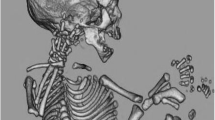Abstract
Grebe dysplasia is a rare skeletal dysplasia characterized by severe acromesomelic shortening of the long bones in a proximal to distal gradient of severity, with bones of the hands and feet more severely affected than those of the forearms and legs, which in turn are more severely affected than the humeri and femora. In addition, the bones of the lower extremities tend to be more severely affected than the bones of the upper extremities. Despite the severe skeletal deformities, the condition is not lethal and surviving individuals can have normal intelligence. Herein we report a case of Grebe dysplasia diagnosed at 20 weeks of gestation. Rendered 3-D ultrasound images of the fetal limbs, particularly of the characteristic tiny and globular-looking fingers and toes, were instrumental in accurately characterizing the phenotype prenatally.





Similar content being viewed by others
References
Grebe H (1952) Die achondrogenesis: Ein einfach rezessives Erbmerkmal [The achondrogenesis: a simple recessive inherited trait]. Folia Hered Pathol 2:23–28
Costa T, Ramsby G, Cassia F et al (1998) Grebe syndrome: clinical and radiographic findings in affected individuals and heterozygous carriers. Am J Med Genet 75:523–529
Mundlos S, Horn D (2014) Grebe dysplasia; Hunter-Thompson dysplasia; Du Pan dysplasia; chondrodysplasia, acromesomelic, BMPR1B type. In: Mundlos S, Horn D (eds) Limb malformations: an atlas of genetic disorders of limb development. Springer, Berlin Heidelberg, pp 247–250
Bonafe L, Cormier-Daire V, Hall C et al (2015) Nosology and classification of genetic skeletal disorders: 2015 revision. Am J Med Genet A 167:2869–2892
Muñoz Rojas MV, Gonçalves LF (2002) Grebe-Quelce-Salgado chondrodystrophy: prenatal diagnosis of two new cases in unrelated families in southern Brazil. Am J Med Genet 113:193–199
Quelce-Salgado A (1964) A new type of dwarfism with varions bone aplasias and hypoplasias of the extremities. Acta Genet Stat Med 14:63–66
Cordero DR, Goldberg Y, Basel D et al (2006) Prenatal sonographic diagnosis of Grebe syndrome. J Ultrasound Med 25:115–118
Rahemtullah A, McGillivray B, Wilson RD (1997) Suspected skeletal dysplasias: femur length to abdominal circumference ratio can be used in ultrasonographic prediction of fetal outcome. Am J Obstet Gynecol 177:864–869
Author information
Authors and Affiliations
Corresponding author
Ethics declarations
Conflicts of interest
None
Rights and permissions
About this article
Cite this article
Goncalves, L.F., Berger, J.A., Macknis, J.K. et al. Grebe dysplasia — prenatal diagnosis based on rendered 3-D ultrasound images of fetal limbs. Pediatr Radiol 47, 108–112 (2017). https://doi.org/10.1007/s00247-016-3705-9
Received:
Revised:
Accepted:
Published:
Issue Date:
DOI: https://doi.org/10.1007/s00247-016-3705-9




